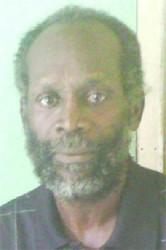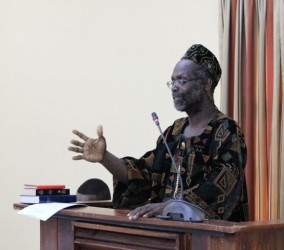Working People’s Alliance (WPA) member Tacuma Ogunseye yesterday testified that the WPA planned to overthrow the then PNC government in the late 1970s through a civil rebellion and attempted to win over the army as part of its efforts.
His testimony was the first detailed account under oath by a senior WPA member of the clandestine activities of the party in its bloody confrontation with the PNC government.
Giving evidence at the Commission of Inquiry (CoI) into the death of WPA co-leader, historian Dr. Walter Rodney’s death, Ogunseye, however, said the party recognised that the rebellion would not bring down the government but would lay the foundation for a regime change.

 Rodney, who had actively opposed the PNC government, was killed in a car near John and Bent streets on June 13, 1980, after a walkie-talkie given to him exploded.
Rodney, who had actively opposed the PNC government, was killed in a car near John and Bent streets on June 13, 1980, after a walkie-talkie given to him exploded.
The PNC has continued to reject any association with the killing, which occurred at a time when the WPA was organising mass public meetings that saw frequent invasion by security forces and other groups.
Ogunseye yesterday explained that the WPA’s political agenda shifted after its members were blamed for the burning down of the National Development Ministry building in 1978. He said the party’s initial purpose was to give itself political legitimacy to contest against other political forces. However, this changed after the building was burnt and fingers were pointed at the WPA and some of its members were arrested for arson. Nevertheless, he denied the WPA’s involvement in the building’s destruction.
The party, he said, began to concentrate on regime change after it came under attack from the government. He stated that after the building was burnt, there was an intense period of political confrontation between the PNC and the WPA.
He said after nearly 34 years, he was still convinced that President Forbes Burnham and the security forces were the masterminds behind Rodney’s death. “I think Burnham was an outstanding Guyanese but he was a politician in my judgment, [that] once he got power, was prepared not to lose that power at all cost… he wanted to hold down power until he died,” he said.
He said Burnham’s politics was very “vindictive” and “personal,” adding that he was convinced that Burnham was prepared to do anything to maintain his power.
Ogunseye said the WPA’s civil rebellion could have been prevented if “Burnham did not point his fingers at the WPA” for the destruction of the Ministry building.
According to Ogunseye, the WPA’s plan was to develop a very open rebellion. He explained that to mobilise a government overthrow they needed an open rebellion. He stated that they then set out to win over the military and prepared for the change by strengthening the WPA’s covert and overt activities. He added that they also sought to form alliances that would endorse the regime change.
He stated that the party started examining ways to overthrow Burnham, such as through winning over the army and invading the Office of the President or his premises and throwing him out of his office, like had been done in some Middle Eastern countries.
But he said they knew that a civil rebellion could not bring down a government, so they used it as a tactic instead. “We knew that the civil rebellion would not bring down the government… but it was a tactic to get the people to endorse a change of government,” he said. “The civil rebellion announced the coming of regime change,” he said.
Ogunseye also admitted that the WPA spied on the PNC government and the religious outfit the House of Israel, which was used by the governing party to disrupt WPA meetings and terrorise party members.
He denied Rodney had any plans to blow up the Georgetown Prison, which was a claim that was peddled at the time of his death.
‘Constant confrontations’
Ogunseye described the period as a time of “rallies, marches and picketing.” “There were constant confrontations,” he said, noting that the government then recognised it was in “a dangerous” political position and started to act against the WPA.
Ogunseye stated that the WPA’s public meetings were broken up and party supporters and members were locked up. He also said police would burn bricks and bottles and toss them onto the podium to disrupt the meetings. He added that the WPA would obtain permission from the police to conduct meetings but when these meetings commenced another set of police would arrive and break it up, under claims that the gatherings were illegal.
He said there were constant arrests and mass searches of the WPA members’ premises.
Video – Part 1
“I slept in every lockup in Georgetown and across the East Coast,” he said, while noting he was arrested 20 times and brought before the courts under the charges of public terror and subversive literature.
He further stated that his house was searched three times.
Ogunseye contended that the arrests were part of the government’s method of intimidating the WPA movement. He noted that members were sometimes kept in police custody for over 72 hours, without reason.
He stated that another form of reaction against the party occurred when Burnham publicly threatened the WPA and Rodney. In 1979, Burnham’s speech was broadcast nationwide.
Security committee
Ogunseye said the WPA did not take the threat lightly and thus constituted the WPA security committee. He said the security body consisted of Rupert Roopnaraine, himself and Rodney. The committee was set up as a self defence tactic, he said, adding that it operated on a “need to know” basis with other members because “people lives were on the line.” Therefore, he said, not all members were aware of the decisions of the body unless they needed to be alerted. “People lives were on the line,” he said. “If we didn’t adopt it we would have had a lot of casualties.”
Ogunseye said that the WPA started to build “cells” of members to further reinforce the security in the party. Twenty-five cells of members were developed in Georgetown, each having a maximum of five persons. The cells were charged with “covert” activities.
Ogunseye admitted to helping in the formation and the supervision of some of these cells. However, he stated he was unaware of the obtaining explosives by the WPA. But he said automatic weapons were collected and given to 12 cell leaders. He, however, denied knowing where the weapons originated from.
He stated they did not have the resources to purchase arms on a large scale or get ammunition into the country. The borders, he said, were watched by the army. The Guyana-Brazil border was ruled out particularly because the Burnham administration had close relations with the Brazilian army.
The notorious recognition handbook
He said a handbook on the profile of WPA members and supporters was produced by a section of the state and given to police officers as a means to easily identify the members. He further stated that he had friends in the police force who showed him the book and he noted that copies were circulated.
A copy of what he called the “notorious recognition handbook” was tendered and marked as an exhibit in the inquiry. On page 26 of the book, Ogunseye’s profile was highlighted with information about his passport number, his address and occupation along with other physical attributes.
Video – Part 2
Walter Rodney’s profile was also pinpointed in the book. Ogunseye said the “notorious recognition handbook” was considered as a “hit list” by a US journalist in the past.
He said that extra-judicial killings were rampant during the PNC government rule from 1964 to 1992. This, he stated, worsened after the PPP government took office.
He indicated that he never knew of Gregory Smith until after Rodney’s death. He said Rodney’s brother Donald had identified Smith as the man who gave Rodney the walkie-talkie which concealed an explosive.
He said Donald’s statement indicated that Smith instructed Walter to get out of the car and walk to the prison so that they could test the range of the device. But Rodney remained in the car and activated the device in his lap. “Gregory Smith wanted Walter to activate the device in the presence of the prison and it would have been to his face and when it explode his face would have been disfigured,” he said passionately.
He further stated that when Donald identified Smith, the army denied his existence. However, a photograph later surfaced with Smith fully clad in his military attire.
He said that Smith and his family fled the country soon after Rodney’s death and that he was aided by the army. “Burnham was being destroyed by his own actions… he couldn’t arrest and convict Smith for Rodney’s killing since he was fearful Smith would crack,” he said.






